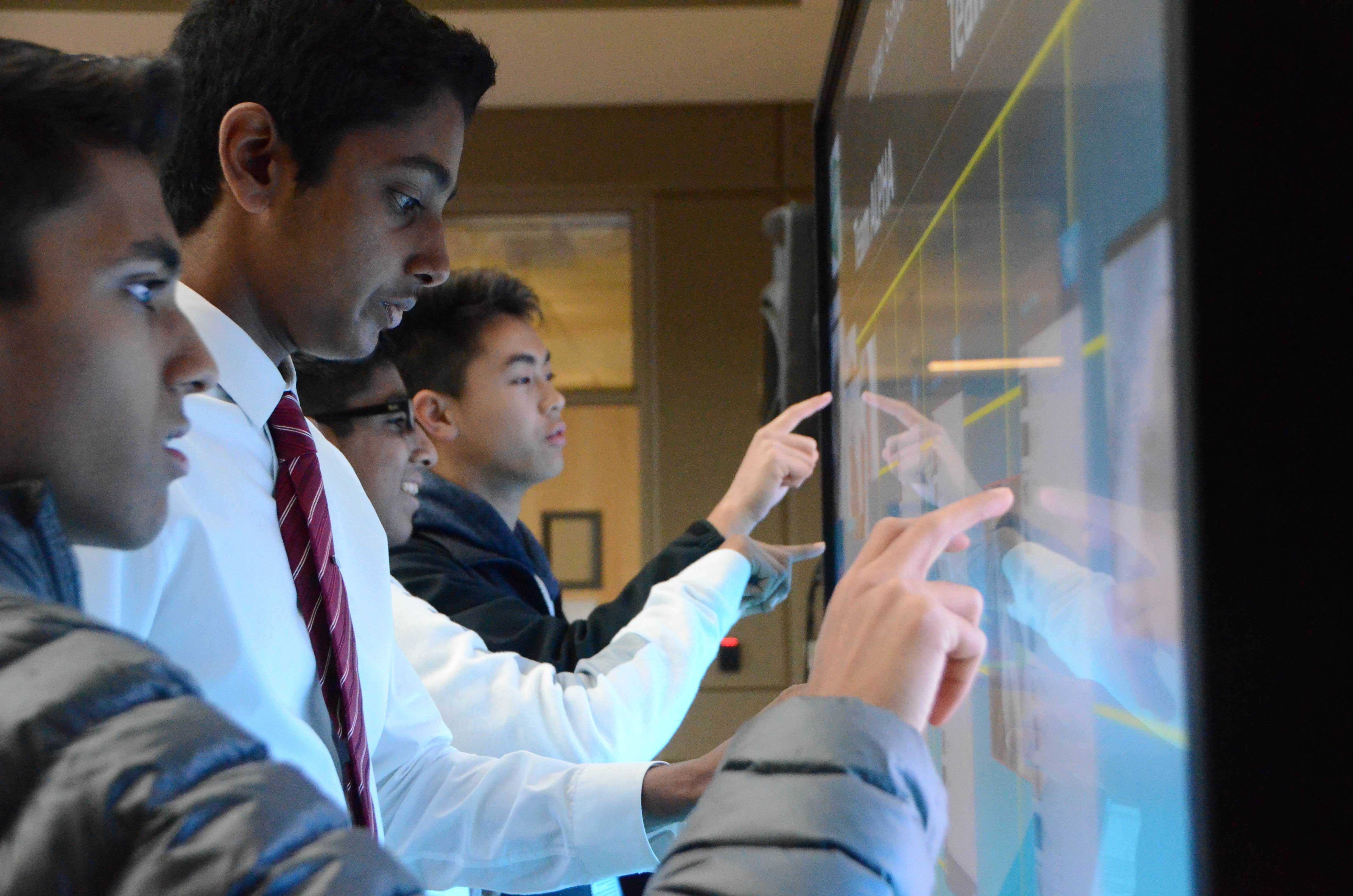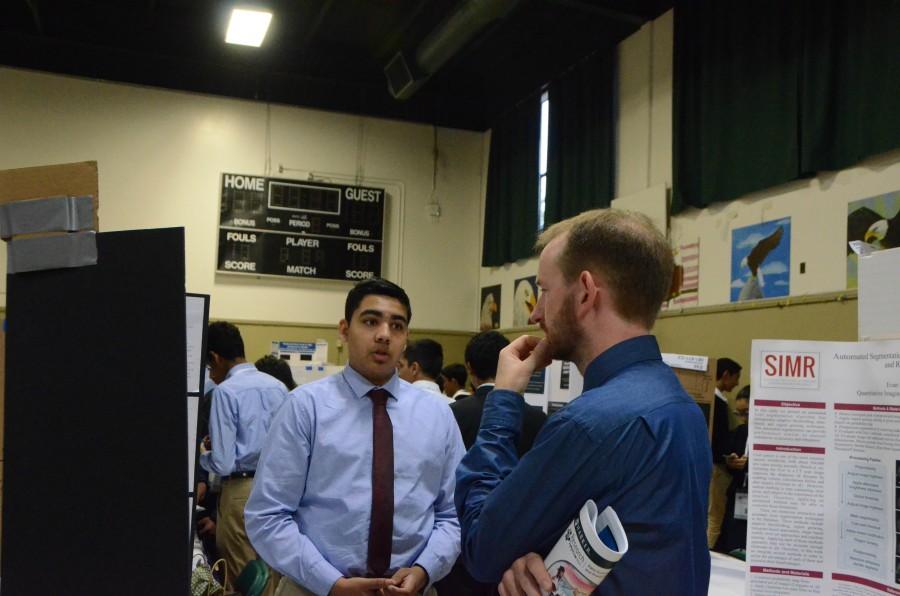Harker holds 11th annual research symposium
April 10, 2016
With a record-breaking number of 700 attendants, the 11th annual science research symposium took place at the upper school yesterday, where presenters held keynotes, workshops and poster presentations for the audience.
This year’s symposium, coordinated by upper school science department chair Anita Chetty and Women in Science, Technology, Engineering and Math (WiSTEM) club, included many changes from last year.
“For one, the theme for this symposium I think resonates with the Harker community,” Chetty said. “I think it brought up our participation significantly – almost double. I’ve always had a vision of the symposium being like any other science conference. This year, I really think we’ve modeled it like that.”
At the symposium, both adults and children shuttled between the gym and Nichols hall, exploring various aspects of research and science offered by students through presentations. A new theme was introduced: “Data Science, Machine Learning and Predictive Analytics,” and keynote speakers gave talks revolving around the theme. In addition, workshops were offered for attendees to participate in activities. The workshops included a lecture on bioinformatics, a tutorial to create a working speaker and a lecture on machine learning.
“I really liked the hands-on lab experiences because it’s a fun way to interact,” WiSTEM club member Jacqueline He (10) said. “I moderated a lot of the talks during the breakout sessions as part of my job.”
After previously registering online using the Evenium website, attendants received event passes in the morning and had the chance to view various poster boards set up in the gym by student presenters. At 8:30 a.m., the first four of four sessions held, in which students gave formal talks pertaining to their research projects to interested audiences.
“I’m here to present my research on neuronal reprogramming. I gave a formal talk, and I’m also here to listen to the different keynotes,” Venkat Sankar (11) said.
After the breakout sessions, SIEMENS finalists David Zhu (11) and Evani Radiya-Dixit (11) presented their research project in the auditorium. Their presentation was followed by a keynote address by CEO and founder of AgilOne Omer Artun on “How machine learning and pattern recognition will transform our relationship with brands we love.” Addresses, such as keynotes, that took place in the auditorium had an increased level of interaction with the audience using the Evenium app “ConnexMe,” where members of the audience could pose questions to the speaker and upvote others.
“I’ve spent the morning moderating talks. It’s really cool that they are really willing to go to the talks,” WiSTEM club member Emily Chen (10) said. “It’s great that we’re having student presentations and keynote speakers as well.”
After the second keynote address by Brienne Ghafourifar on “The Next Chapter of IoT: The intelligence of Things,” the attendants ate lunch and watched the chemistry magic show, hosted by chemistry teachers Mala Raghavan, Dr. David Casso and Andrew Irvine.
“This is such a great meeting,” Dr. Casso said. “All the projects are very interesting to read, and many are driven by really important points. I’m looking forward to meeting the [researchers] and their advisors.”
After two afternoon keynote addresses, one by Harker alumni Alan Malek (‘05) on “Sequential decision making: Modeling how we interact with the world” and another by Jeffrey Rothschild on “Data>Opinion: The data driven revolution,” a panel discussion was held to conclude the symposium, where student researchers and advisors discussed the topic of “The Harker research program: a path, a plan and the real prize.” At the panel, the students shared their research experiences, about how they started, what competitions in which they participated and what advice they would give to aspiring researchers.
“Symposium was a great success,” Rishab Gargeya (11) said. “Many key speakers had a lot of interesting topics to share and discuss. The theme was is really important to us and relevant for the next decade to come, and that’s why I feel there is so much interest.”
Next year’s theme for the symposium will emphasize virtual reality and artificial intelligence, along with a possible forum to discuss real world problems.
Dr. Fei Fei Li, director of the Artificial Intelligence Lab at Stanford University, has been selected as one of the keynote speakers next year.
“Next year, I think we can discuss problems in the world and their solutions,” Chetty said. “If this really is a meeting of the minds, I am sure we are capable of holding a forum for next year.”
Middle and upper school students participate in poster sessions
As one of the many events at the annual Harker Research Symposium, students had the opportunity to showcase their research projects.
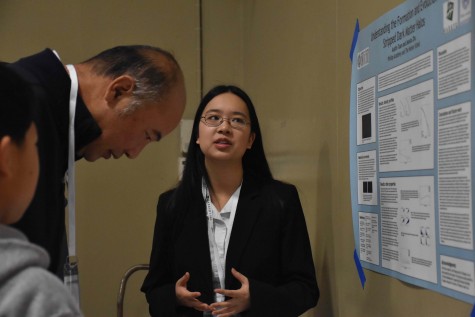 “Understanding the formation and evolution of stripped dark matter halos”
“Understanding the formation and evolution of stripped dark matter halos”
Jessica Zhu (12) worked with Austin Tuan (11) on researching dark matter halos, specifically studying the aspects of those halos while attempting to draw connections between different properties.
“My partner and I studied a bunch of data from simulations from dark matter halos and many properties including density, concentration and the shape of the halo,” she said. “Then, we found various relations between those properties, graphed them and then we drew equations.”
According to Jessica, a majority of her project included coding. Each week, using the Python programming language, she analyzed a large amount of data, in which she was required to pull out meaningful relationships.
The idea behind her research started at a summer program before her senior year.
“I applied for astrophysics because I really do enjoy physics,” she said. “Astrophysics was something related enough for me to have an interest in it, but it was never something I studied in school.”
Much of what she learned from her mentors is not only related to research but also communication skills.
“They taught me not only a lot about how to research but also how to your communicate ideas, which is equally as important in the scientific research community,” Jessica said. “Presenting makes it that you have to talk in a very clear and simple language, which really forces you to have a very deep understanding of your research as well.”
 “The Effect of age on human thinking processes”
“The Effect of age on human thinking processes”
Inspired by Daniel Kahneman’s “Thinking, Fast and Slow,” Shreyas Chandrashekaran (10) decided to pursue this newfound idea in his research project.
“[Kahneman] presented a different view of how we think, where the brain was split into two parts called system one and system two; system one is the fast thinking part of your brain and system two is the reasoning [part] and it takes longer for it to come up with answers,” Shreyas said. “So people use system one more than system two in day-to-day life because they take these shortcuts which makes it easier for them to think.”
Shreyas’ project dealt with inherent responses in three different age groups of children ages four to five, adolescents ages 13 to 18 and adults 18 and above.
“This is when people explain complex patterns or reasons for objects by using inherent features of those objects. Basically, people using this behavior show use of meta shotgun, which is a phenomenon where, when trying to explain complex patterns, people often answer an incorrect question, the one not being asked,” he said. “I found that children exhibited the characteristic a lot more than adults did.”
He believes that the significance of putting together a science research project is to benefit society as a whole.
“I really feel like every project here is important, and all of them have interesting locations for society as a whole,” he said. “I feel that it’s important to show those views to those around you, so you can widen the knowledge of these subjects.”
 “The role of VCAM 1+ sinusoidal endothelial cells in hematopoietic stem cell trafficking”
“The role of VCAM 1+ sinusoidal endothelial cells in hematopoietic stem cell trafficking”
When she was five years old, Natalie Simonian (12) started to developed an interest in stem cell research. Now, in her senior year, she researched stem cells in bone marrow during transplants.
“Although we have been doing these kinds of stem cell transparents for a really long time, scientists don’t understand how these stem cells behave out of the bone, which is what we’re trying to figure out,” Natalie said. “If we are able to figure it out, we’ll be able to design drugs that target that ,and we can give the donor that drug to pull out more stem cells, less bone marrow and less blood from them.”
Her research was divided into three main subsections, creating three different experiments going on simultaneously.
“[In] the first one we were creating a mouse model, so that meant bringing in a bunch of mice and isolating their DNA and trying to find what kind of genes they have; [the] second thing we were trying to do was to look at the bone marrow to see what type of cells were in there, how to distinguish those cells, and what they look like,” she said. “The third thing we did was we created that system in a dish to see how it was outside the bone. We put a layer of cells that represented the subcells that they come in and out of, and we made a layer on one side and saw how many made it through.”
Natalie also expressed her favorite part of the process.
“I’m obviously very passionate and interested in this project, so I really liked talking about it and also being able to show the research to other people.”
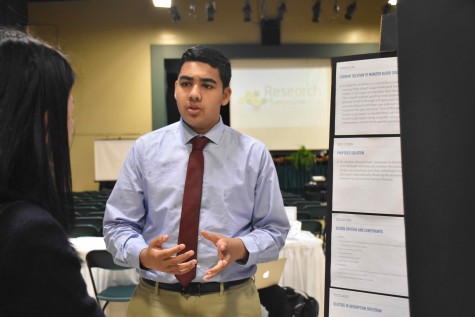 “Non-invasive glucose monitor”
“Non-invasive glucose monitor”
As Keval Shah (9) was greatly affected when his grandmother was diagnosed with diabetes, he wanted to find a way to help those living with this problem.
“As I grew up with her, she was constantly pricking herself, and I saw that her hand was constantly getting calluses,” he said. “Even though I can’t cure diabetes, I can probably have a lasting effect on people who have diabetes by having a non-evasive way of measuring glucose.”
Keval explains the processes and procedures he took to come to his result.
“The first thing I had to do was to find a way to solve this non-evasively, whether it was using x-rays or light; I found something that pumps glucose itself and I realized that it had a ten micrometer wavelength. If you emit light at ten micrometers, it will be able to go through the skin,” he said. “The information can be relayed through to the your smartphone; the app is to use the light to find out how much light is in your body.”
According to Keval, the most interesting part of his research experience was engineering and programming the system to relay the information.
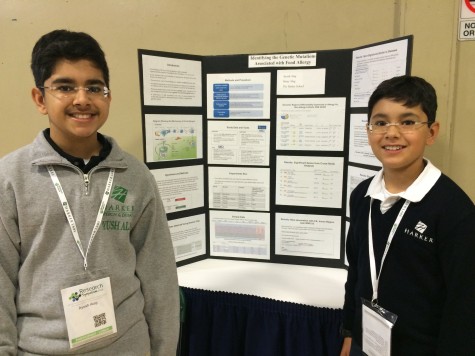 “Identifying the Genetic Mutations Associated with Food Allergy”
“Identifying the Genetic Mutations Associated with Food Allergy”
Siblings Ayush Alag (9) and Shray Alag (7) researched genetic mutations related to food allergy.
“Over 25 million people every year have problems with food allergy, so obviously it’s really a big problem and we want to stop [it],” Ayush said.
They used different tools to analyze and identify the genomic loci points that cause food allergy.
“We organized different experiments with different groups that we received from a public data set, and with these we ran several experiments using GEO2R tool,” Ayush said. “Then, we used another tool called the Illumina NextBio research tool, which gave us some data of the top genomic points that were associated with food allergy.”
Ayush and Shray were inspired to do this project because Ayush has a food allergy called Tonox.
Their project went beyond what was previously published research in providing insights to understanding the genomic basis of food allergy.
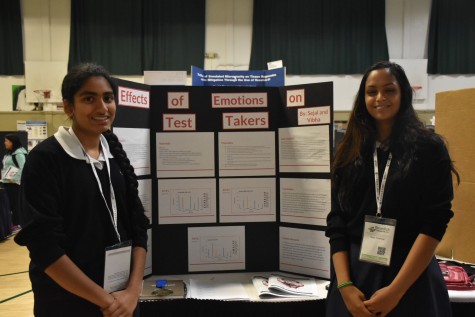 “Effects of Emotions on Test Takers”
“Effects of Emotions on Test Takers”
Sajel Krishnan (8) and Vibha Arramreddy (8) wondered which emotion would help a student do well on a test.
“What we did was in this test we took five emotions and a control group and decided to see which one would best benefit the student,” Sajel said.
Each student was required to either watch a video or do an exercise before taking the test with a certain emotion. The five different emotions were happy, sad, motivated, scared and relaxed. The test contained 10 questions from Math and English with an eight minute time limit.
“Our results that we found was that in the end when we compile all the data is that happy showed the highest grade,” Sajel said. “So basically if you enter a test smiling and laughing you should do well if you prepared the information.”
They have trouble mentally preparing for tests and figured that other students might share this problem. They were inspired to do this project to inform students about the best attitude to adapt to while preparing for a test.
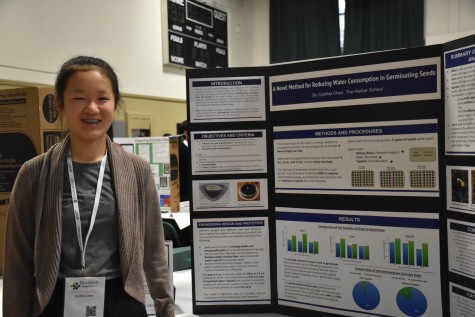 “A novel methods for reducing water consumption in germinating seeds”
“A novel methods for reducing water consumption in germinating seeds”
To help relieve the drought condition in California, Cynthia Chen (8) decided to do a project about finding the ways to reduce water use by farmers.
“My project aims to decrease water consumption in germinating seeds and basically helping the drought from that,” Cynthia said.
She developed a water retaining capsule made of a pod, a filter, and a layer of water crystals in between. This device provided the germinating seed with access to water.
“I’ve devised a capsule in order to get the objectives, then I tested in normal farming conditions but with different levels of water and I collected results,” Cynthia said.
She conducted the test on three different types of plants. She observed that the capsule helped the seeds germinate faster and also increased its chances of survival. This method demonstrated that it was effective in reducing water consumption during germination.
“What inspired me to do this project was that like all of my family and government too were bugging me to to take shorter showers to use less water in the home,” Cynthia said. “I did some research on what exactly causes the drought and I found out the most of the drought was caused by farming and not in household use.”
Symposium under founder Anita Chetty’s magnifying glass
For Upper School Science Department Chair Anita Chetty, no research is complete until shared with other peers and scholars – one of the main reasons Chetty was prompted to gather twenty sets of parents and students into the gym in April of 2006 for dozens of poster sessions and talks the first ever Harker Research Symposium.
“I wanted to have a non-competitive forum where students would simply gather and share,” she said. “The only prize was simply just being able to describe what you did whether you had really significant findings or not. It was just about your findings and what you learned from them was you went through the process.”
With this exact vision, Chetty has been able to garner over 600 students, faculty, and parents alike into Nichols Hall annually for the Symposium. The most recent one taking place this past Saturday, April 9, 2016.
Chetty has always created and planned the symposium in hopes of mimic a conference that any scientist would go to. In order to this, Chetty starts planning for the poster sessions, talks, keynote speakers the minute the previous Symposium ends.
“The other element that I wanted to have in there was to illustrate to students how research and development actually leads to career opportunities, drives the economy, changes people lives, so I knew it was important to have corporations there discussing what they were marketing or what they were developing,” she said.
Besides forming a platform for Upper and Middle school students to showcase their scientific research, Chetty also hoped that the Symposium would be a home for inspiration for younger students to cultivate a love of STEM, which led to the creation of STEMBuddies.
“Now this is a K-12 event,” she said. “It allows Harker to showcase, especially, the Upper School, the kind of technology we have and gives us the opportunity to show the caliber of teaching that is going on.”
Chetty hopes with the incorporation of the many high pieces of scientific technology like the anatomy table, the thermo camera, and chromatography that future and current parents and students not only imbibe Harker’s philosophy of teaching in a highly hands-on and very interactive manner but also feel a part of the symposium experience. Something that Chetty and WISTEM club members hoped to do with the usage of the app, ConnexMe.
“We want the audience to engage with the speaker asking questions which we have done for a couple of years now where they vote on the question so that not just any random questions get asked,” she said.
However, the creation and envisioning of an event as large and as intricate as the Symposium is not done by Chetty alone. With the help of parent volunteers, students, and all Harker departments, Chetty is able to come up with a topic and keynote speaker best appropriate for the following year.
In most occasions, Chetty brainstorms with parent volunteers to see what topics are out in the industry right now and will be of interest to Harker students. Next year, the keynote speaker for the Research Symposium centered on artificial intelligence and virtual reality will be Director of Artificial Intelligence Lab at Stanford University’s Dr. Fei-Fei Li.
“We are doing this only because Mr. Keller came back from a TedTalk and he was really fascinated by artificial intellgivence and I have been trying for several years now to get someone to come from Google or Stanford and was finally able able to get a speaker so that will now a drive a lot of the corporate exhibitors,” she said.
Chetty explains that finalizing the speaker this early will allowe her to find appropriate workshops for next year and finding corportations related to virtual reality.
“There is a lot of networking that I do throughout the year, but I have my team here at Harker also,” she said.
However, the final piece to making the Symposium fully representative of an official science conference came this year with the inclusion of workshops. Workshops were run by Marcos Woehrmann on bioinformatics, Scott Pflaumer on how to make and take your own speaker, and Somnath Banerjee on machine learning and predictive analysis.
After eleven years of the Symposium, Chetty remains amazed at the caliber and dedication of all students participating or attending the Symposium.
“I think it is important to challenge our students to think about the issues that are impacting our planet right now and how it is that we might come up with solutions for some of those problems,” she said. “So I want to incoportate that in so that not only do we have the posters and the talks and interactive activities, that we also have an opporuntiy for Harker students to engage in dialogue with one another trying to come up with global solutions.”
